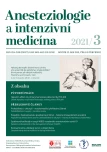-
Medical journals
- Career
Central anticholinergic syndrome – forgotten diagnosis
Authors: J. Vagner 1; J. Votava 1; A. Spálený 1
Authors‘ workplace: Klinika anesteziologie, resuscitace a intenzivní medicíny 1. lékařská fakulta Univerzity Karlovy a Ústřední vojenská, nemocnice Praha
Published in: Anest. intenziv. Med., 32, 2021, č. 3, s. 164-167
Category: Case Reports
Overview
Our article presents a case report of patient with persistent impaired consciousness on awakening from general anesthesia. A 65-year-old patient with Crohn’s disease was indicated for scheduled laparoscopic assisted ileocecal resection. The operation was performed without complications under general anesthesia. In the immediate post-anesthetic period, a quantitative disorder of consciousness of the nature of significant somnolence to sopor dominated. The state of consciousness did not improve over time and therefore naloxone and aminophyllin were administered to patients with a suspected prolonged opiate effects. However, their administration did not lead to an adjustment of the consciousness. After excluding all other causes of disturbances of consciousness, we considered central anticholinergic syndrome (CAS) and proceeded to the administration of physostigmine. Patients regained full alertness, accelerated psychomotor pace, and improved muscle strength within a minute. Further course of hospitalization without any sights.
Keywords:
prolonged recovery from anesthesia – physostigmine – anticholinergic syndrome
Sources
1. Misal US, Joshi SA, Shaikh MM. Delayed recovery from anesthesia: A postgraduate educational review. Anesth Essays Res. 2016 May‑Aug; 10(2): 164–172.
2. Hess L, Málek J, Schreiberová J. Fyzostigmin a jeho použití v současné anesteziologii a intenzivní medicíně. Anest. Intenziv.Med. 2006; 17(6): 287–294.
3. Rupreht J, Dworacek B. Centrální anticholinergní syndrom (CAS) v pooperačním období. Anesteziologie a neodkladná péče. 1999; 10(3): 94–100.
4. Mark Su, MD, MPH. Matthew Goldman, MD. Anticholinergic poisonong. UpToDate. 2020 [cit. 2020-03-24]. Dostupné z: https://www.uptodate.com/contents/anticholinergic‑poisoning.
5. Rasimas JJ, Sachdeva KK, Donovan JW. Revival of an antidote: bedside experience with physostigmine. Toxicology Communications. 2018; 2(1): 85–101. doi: 10.1080/24734306.2018.1535538
6. Cao X, Cui Y, White PF, Tang J, Ma H. Central anticholinergic syndrome vs. idiosyncratic reaction triggered by a small IV dose of atropine. Acta Anaesthesiol Scand. 2016; 60(2): 270–273.
7. Cook B, Spence AA. Post‑operative central anticholinergic syndrome. Eur J Anaesthesiol. 1997 Jan; 14(1): 1–2.
8. Piper SN. Do patients profit from physostigmine in recovery from desflurane anaesthesia? Acta Anaesthesiol Scand. 2007; 51(3): 278–283.
9. Cho H, Kim J. Development of postoperative central anticholinergic syndrome due to low‑dose intravenous fentanyl. Saudi J Anaesth. 2018; 12(2): 328–331.
10. Moos DD. Central anticholinergic syndrome: a case report. J Perianesth Nurs. 2007 Oct; 22(5): 309–321. doi: 10.1016/j.jopan.2007. 05. 006.
Labels
Anaesthesiology, Resuscitation and Inten Intensive Care Medicine
Article was published inAnaesthesiology and Intensive Care Medicine

2021 Issue 3-
All articles in this issue
- Má být studium odborných zahraničních zdrojů považováno za povinnost českých lékařů v rámci jejich celoživotního vzdělávání?
- Vliv nitrožilních a inhalačních anestetik na pooperační kognitivní funkce u starších pacientů po laparoskopických břišních výkonech
- Prehabilitation in surgery – narrative review
- Padesátiletí umělé plicní ventilace – 1970–2020
- Propofol has already been used in Czechoslovakia for 30 years – history of intravenous anaesthetics
- Systemic corticosteroids in the management of covid-19 ARDS
- Compartments and nerve blocks in the leg bellow knee
- Central anticholinergic syndrome – forgotten diagnosis
- Leukocyty, mikroagregace a reakce na hypoxemii v mikrocirkulaci pacientů při koronarovirové chorobě 2019
- Surgical vena cava filter retrieval in anaesthesiologist’s and surgeon’s views
- Postavení a role anesteziologů v přicházející transformaci zdravotní péče a perioperační medicíny
- Hyperbarická oxygenoterapie a onemocnění covid-19?
- Klinický význam epiglotis
- MEZIOBOROVÉ STANOVISKO (evidenční číslo ČSARIM: 23/2021)
- doc. MUDr. Ivan Čundrle, CSc., 9. 1. 1947 – 28. 5. 2021
- Heparin’s effect on primary hemostasis detected by PFA-200
- Anaesthesiology and Intensive Care Medicine
- Journal archive
- Current issue
- Online only
- About the journal
Most read in this issue- Central anticholinergic syndrome – forgotten diagnosis
- Propofol has already been used in Czechoslovakia for 30 years – history of intravenous anaesthetics
- Systemic corticosteroids in the management of covid-19 ARDS
- Compartments and nerve blocks in the leg bellow knee
Login#ADS_BOTTOM_SCRIPTS#Forgotten passwordEnter the email address that you registered with. We will send you instructions on how to set a new password.
- Career

